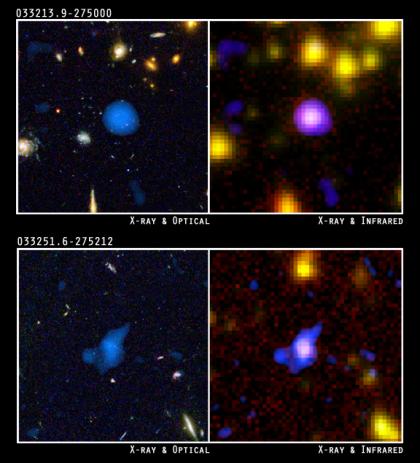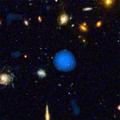Hidden Black Holes Uncovered by Combined Effort of NASA's Great Observatories

Credit: NASA, ESA, A. M. Koekemoer (STScI), M. Dickinson (NOAO) and The GOODS Team
The combined powers of three of NASA's Great Observatories -- the Hubble Space Telescope, the Chandra X-ray Observatory, and the Spitzer Space Telescope -- have been used to find evidence of a hidden population of supermassive black holes in the universe. All these space telescopes took a long look at a small region of the sky (called the Great Observatories Origins Deep Survey field, or the GOODS field for short). When visible light and X-ray light from this region were compared, astronomers found numerous X-ray sources that can be identified as supermassive black holes in young galaxies billions of light years from Earth. But the X-ray glow from other sources had no obvious host galaxies in optical light. Two of these X-ray sources are identified by the central blue spots in the composite Hubble-Chandra images on the upper and lower left panels.
The Chandra-Spitzer composite X-ray/infrared images on the upper and lower right panels demonstrate that these mysterious sources are also detected at infrared wavelengths. This indicates that the galaxies around these supermassive black holes are heavily obscured by dust. Visible light is absorbed by the dust, which is heated by the absorption and glows at infrared wavelengths.
Astronomers have suspected that many supermassive black holes may have been missed in optical surveys because they were shrouded in dust. Combined data from Chandra, Spitzer and Hubble should soon yield a much more complete census of the number of black holes in the early universe
|
||||||||||||||||||||||
This is an astronomical image montage that features supermassive black holes. The image consists of four panels showing objects named 033213.9-275000 (two images on top with X-rays and optical light vs X-ray and infrared) and 033251.6-275212 (two images on the bottom, again with one panel of X-ray and optical and then another with X-ray and infrared). These are two distant, dust-shrouded supermassive black holes in the Great Observatory Origins Deep Survey (GOODS) field. The colors in the image include blue, white, yellow, and purple set on dark backdrops. The shapes in the images are irregularly shaped, with some appearing to be circular (top images) and some appearing to be elongated and almost angular (bottom images). The key structures in the image are the supermassive black holes, which are in the centermost circles in each panel. The combined powers of three of NASA's Great Observatories -- the Hubble Space Telescope, the Chandra X-ray Observatory, and the Spitzer Space Telescope -- were used to find evidence of this hidden population of supermassive black holes in the universe. All these space telescopes took a long look at a small region of the sky of the GOODS field. When visible light and X-ray light from this region were compared, astronomers found numerous X-ray sources that can be identified as supermassive black holes in young galaxies billions of light years from Earth.





